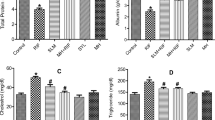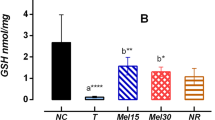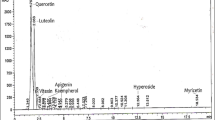Abstract
Introduction
Isoniazid (INH) and rifampicin (RIF), the most common anti-tubercular therapy, causes hepatotoxicity through a multi-step mechanism in certain individuals. The present study was an attempt to evaluate the hepatoprotective effect of coenzyme Q10 against INH + RIF-induced hepatotoxicity in Wistar albino rats.
Methods
Hepatotoxicity was induced by the oral administration of INH + RIF (50 mg/kg b.w. each/day) in normal saline water for 28 days. The hepatoprotective effect of coenzyme Q10 (10 mg/kg b.w./day) was compared with that of the standard drug silymarin (25 mg/kg b.w./day). Animals were sacrificed at the end of the study period, and blood and liver were collected for biochemical, immunological and histological analyses.
Results
Evaluation of biochemical parameters showed that coenzyme Q10 treatment caused significant (P < 0.05) reduction in the elevated levels of serum liver function markers and restored normal levels of total protein, albumin and lipids in INH + RIF-treated rats. Also, it was observed that coenzyme Q10 was able to restore normal levels of enzymic antioxidants, reduced glutathione and lipid peroxidation in the INH + RIF-treated rats. Coenzyme Q10 was found to effectively reduce the extent of liver damage caused due to INH + RIF. In addition, the levels of IL-10 and IL-6 were significantly elevated in the INH + RIF-induced rats treated with CoQ10.
Conclusion
Our study indicates the protective role of coenzyme Q10 in attenuating the hepatotoxic effects of INH + RIF in a rat model and that it could be used as a food supplement during anti-tubercular therapy.




Similar content being viewed by others
Abbreviations
- ATDs:
-
Antitubercular drugs
- CoQ10:
-
Coenzyme Q10
- DAH:
-
Diacetyl hydrazine
- DMN:
-
Dimethyl nitrosamine
- INH:
-
Isoniazid
- MAH:
-
Monoacetyl hydrazine
- RIF:
-
Rifampicin
References
Aithal GP, Ramsay L, Daly AK, Sonchit N, Leathart JBS, Alexander G, et al. Hepatic adducts, circulating antibodies, and cytokine polymorphisms in patients with diclofenac hepatotoxicity. Hepatology. 2004;39(5):1430–40.
Alam MA, Rahman MM. Mitochondrial dysfunction in obesity: potential benefit and mechanism of Co-enzyme Q10 supplementation in metabolic syndrome. J Diabetes Metab Disord. 2014;13:60.
Attri S, Rana SV, Vaiphei K, Sodhi CP, Katyal R, Goel RC, et al. Isoniazid- and rifampicin-induced oxidative hepatic injury—protection by N-acetylcysteine. Hum Exp Toxicol. 2000;19(9):517–22.
Boelsterli UA, Lee KK. Mechanisms of isoniazid-induced idiosyncratic liver injury: emerging role of mitochondrial stress. J Gastroenterol Hepatol. 2014;29(4):678–87.
Bourdi M, Masubuchi Y, Reilly TP, Amouzadeh HR, Martin JL, George JW, et al. Protection against acetaminophen-induced liver injury and lethality by interleukin 10: role of inducible nitric oxide synthase. Hepatology. 2002;35(2):289–98.
Burk O, Koch I, Raucy J, Hustert E, Eichelbaum M, Brockmöller J, et al. The induction of cytochrome P450 3A5 (CYP3A5) in the human liver and intestine is mediated by the xenobiotic sensors pregnane X receptor (PXR) and constitutively activated receptor (CAR). J Biol Chem. 2004;279(37):38379–85.
Byrne JA, Strautnieks SS, Mieli-Vergani G, Higgins CF, Linton KJ, Thompson RJ. The human bile salt export pump: characterization of substrate specificity and identification of inhibitors. Gastroenterology. 2002;123(5):1649–58.
Choi H-K, Pokharel YR, Lim SC, Han H-K, Ryu CS, Kim SK, et al. Inhibition of liver fibrosis by solubilized coenzyme Q10: role of Nrf2 activation in inhibiting transforming growth factor-β1 expression. Toxicol Appl Pharmacol. 2009;240(3):377–84.
Chowdhury A, Santra A, Kundu S, Mukherjee A, Pandit A, Chaudhuri S, et al. Induction of oxidative stress in antitubercular drug-induced hepatotoxicity. Indian J Gastroenterol. 2001;20(3):97–100.
Dong Y, Huang J, Lin X, Zhang S, Jiao Y, Liang T, et al. Hepatoprotective effects of yulangsan polysaccharide against isoniazid and rifampicin-induced liver injury in mice. J Ethnopharmacol. 2014;152(1):201–6.
Ellard GA, Gammon PT. Pharmacokinetics of isoniazid metabolism in man. J Pharmacokinet Biopharm. 1976;4(2):83–113.
Giannini EG, Testa R, Savarino V. Liver enzyme alteration: a guide for clinicians. Can Med Assoc J. 2005;172(3):367–79.
Grosset J, Leventis S. Adverse effects of rifampin. Clin Infect Dis. 1983;5(Supplement 3):S440–6.
Habig WH, Pabst MJ, Jakoby WB. Glutathione S-transferases the first enzymatic step in mercapturic acid formation. J Biol Chem. 1974;249(22):7130–9.
James LP, Lamps LW, McCullough S, Hinson JA. Interleukin 6 and hepatocyte regeneration in acetaminophen toxicity in the mouse. Biochem Biophys Res Commun. 2003;309(4):857–63.
Kanebratt KP, Diczfalusy U, Bäckström T, Sparve E, Bredberg E, Böttiger Y, et al. Cytochrome P450 induction by rifampicin in healthy subjects: determination using the karolinska cocktail and the endogenous CYP3A4 marker 4beta-hydroxycholesterol. Clin Pharmacol Ther. 2008;84(5):589–94.
Kettawan A, Takahashi T, Kongkachuichai R, Charoenkiatkul S, Kishi T, Okamoto T. Protective effects of coenzyme Q10 on decreased oxidative stress resistance induced by simvastatin. J Clin Biochem Nutr. 2007;40(3):194–202.
King J. The dehydrogenases or oxidoreductases— lactate dehydrogenase. In: Van D, editor. Practical clinical enzymology. London: Van Nostrand; 1965. p. 93–193.
Lee J, Nakagiri T, Oto T, Harada M, Morii E, Shintani Y, et al. IL-6 amplifier, NF- B-triggered positive feedback for IL-6 signaling, in grafts is involved in allogeneic rejection responses. J Immunol. 2012;189(4):1928–36.
Lian Y, Zhao J, Xu P, Wang Y, Zhao J, Jia L, et al. Protective effects of metallothionein on isoniazid and rifampicin-induced hepatotoxicity in mice. Ho W, editor. PLoS ONE. 2013;8(8):e72058.
Louis H, Le Moine O, Peny M, Quertinmont E, Fokan D, Goldman M, et al. Production and role of interleukin-10 in concanavalin a-induced hepatitis in mice. Hepatology. 1997;25(6):1382–9.
Marklund S, Marklund G. Involvement of the superoxide anion radical in the autoxidation of pyrogallol and a convenient assay for superoxide dismutase. Eur J Biochem FEBS. 1974;47(3):469–74.
Martinet W, Knaapen MW, De Meyer GR, Herman AG, Kockx MM. Oxidative DNA damage and repair in experimental atherosclerosis are reversed by dietary lipid lowering. Circ Res. 2001;88(7):733–9.
McGeachy MJ, Bak-Jensen KS, Chen Y, Tato CM, Blumenschein W, McClanahan T, et al. TGF-β and IL-6 drive the production of IL-17 and IL-10 by T cells and restrain TH-17 cell-mediated pathology. Nat Immunol. 2007;8(12):1390–7.
Moron MS, Depierre JW, Mannervik B. Levels of glutathione, glutathione reductase and glutathione S-transferase activities in rat lung and liver. Biochim Biophys Acta. 1979;582(1):67–78. BBA - Gen Subj.
Ohkawa H, Ohishi N, Yagi K. Assay for lipid peroxides in animal tissues by thiobarbituric acid reaction. Anal Biochem. 1979;95(2):351–8.
Ohkura K, Fukino K, Shinohara Y, Hori H. N-Acetyl transferase 2 polymorphisms associated with isoniazid pharmacodynamics: molecular features for ligand interaction. Anticancer Res. 2010;30(8):3177–80.
Pachkoria K, Lucena MI, Crespo E, Ruiz-Cabello F, Lopez-Ortega S, Fernandez MC, et al. Analysis of IL-10, IL-4 and TNF-α polymorphisms in drug-induced liver injury (DILI) and its outcome. J Hepatol. 2008;49(1):107–14.
Rae JM, Johnson MD, Lippman ME, Flockhart DA. Rifampin is a selective, pleiotropic inducer of drug metabolism genes in human hepatocytes: studies with cDNA and oligonucleotide expression arrays. J Pharmacol Exp Ther. 2001;299(3):849–57.
Rana SV, Pal R, Vaiphie K, Singh K. Effect of different oral doses of isoniazid–rifampicin in rats. Mol Cell Biochem. 2006;289(1–2):39–47.
Rotruck JT, Pope AL, Ganther HE, Swanson AB, Hafeman DG, Hoekstra WG. Selenium: biochemical role as a component of glutathione peroxidase. Science. 1973;179(4073):588–90.
Sinha AK. Colorimetric assay of catalase. Anal Biochem. 1972;47(2):389–94.
Skakun NP, Shman’ko VV. Synergistic effect of rifampicin on hepatotoxicity of isoniazid. Antibiot Med Biotechnol. 1985;30(3):185–9. Minist Meditsinskoĭ Promyshlennosti SSSR.
Steele MA, Burk RF, DesPrez RM. Toxic hepatitis with isoniazid and rifampin. A meta-analysis. Chest. 1991;99(2):465–71.
Steensberg A, Fischer CP, Keller C, Møller K, Pedersen BK. IL-6 enhances plasma IL-1ra, IL-10, and cortisol in humans. Am J Physiol Endocrinol Metab. 2003;285(2):E433–7.
Steuerwald NM, Foureau DM, Norton HJ, Zhou J, Parsons JC, Chalasani N, et al. Profiles of serum cytokines in acute drug-induced liver injury and their prognostic significance. PLoS One. 2013;8(12):e81974.
Vanhoof J, Landewe S, Van Wijngaerden E, Geusens P. High incidence of hepatotoxicity of isoniazid treatment for tuberculosis chemoprophylaxis in patients with rheumatoid arthritis treated with methotrexate or sulfasalazine and anti-tumour necrosis factor inhibitors. Ann Rheum Dis. 2003;62(12):1241–2.
Yue J, Peng R, Yang J, Kong R, Liu J. CYP2E1 mediated isoniazid-induced hepatotoxicity in rats. Acta Pharmacol Sin. 2004;25(5):699–704.
Acknowledgments
The authors would like to thank VIT University for providing the facilities for conducting this study.
Conflict of interest
The authors declare that there are no conflicts of interest.
Author information
Authors and Affiliations
Corresponding author
Rights and permissions
About this article
Cite this article
Baskaran, U.L., Sabina, E.P. The food supplement coenzyme Q10 and suppression of antitubercular drug-induced hepatic injury in rats: the role of antioxidant defence system, anti-inflammatory cytokine IL-10. Cell Biol Toxicol 31, 211–219 (2015). https://doi.org/10.1007/s10565-015-9305-x
Received:
Accepted:
Published:
Issue Date:
DOI: https://doi.org/10.1007/s10565-015-9305-x




